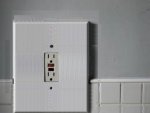Here's an example of the kind of hack drywall work I was seeing today while trimming a house. While it's not usually this bad, I have to say I encounter more bad drywall work than good. This causes me to have to use more labor and materials (levelers, shims, arc shields) to trim than I should. I showed the owner and he said the guy would come back and patch the enormous holes now showing around the cover plate, but that doesn't help me.
In addition to the bad cuts and depth issues, he buried two of my boxes which I already informed the owner I will be charging extra to locate and expose. (I can see a big ass bulge in one of the spots. Guess the drywaller didn't check his work.)
I'm thinking about a couple of solutions:
(1) Use adjustable depth boxes for all boxes.
(2) Adding a "poor workmanship by drywaller" extra charge in my contracts.
How do you guys deal with this? Is there some product that helps?


